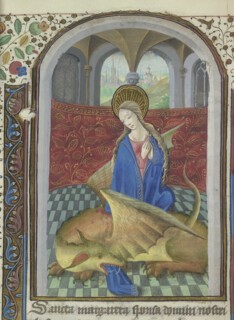Margaret the Dragon Slayer
Mary Wellesley
In an 11th-century English life of Saint Margaret, or Marina, of Antioch, there is a moment when she gets the devil in what martial artists call a ‘submission hold’. ‘The holy Margaret rose up and seized the devil by the hair, threw him to the ground, and put her left foot upon his neck and said: “yield you wretch!”’ (‘Seo eadiga Margarete upparas and þone deofol be þan fexe gefeng and hine niþer to eorðan gewearp, and hi hirne swiðre fot upon his swire gesette, and to him cweað: “Geswic þu earming!”’) I love St Margaret in the same way that I love Wonder Woman.
Some versions of Margaret’s legend describe the Evil One appearing to her in the shape of a dragon. In an early 13th-century text, the dragon comes at her with a ‘sariliche muth’ (‘horrible mouth’) and, stretching out its tongue all the way to her heels, swallows her whole. Margaret deploys a powerful weapon – her rood-token – and the dragon bursts in two. She emerges unscathed from its belly. According to a 15th-century stanzaic life of Margaret, it is simply ‘thorugh vertue of her’ that the dragon ‘braste’.
In depictions of the scene, Margaret usually has a face of beatific calm, standing in the wreckage of the dragon’s body. Often a section of her robe can be seen hanging from the beast’s mouth. The images frequently appear in books of hours, especially those made for women. Margaret was the patron saint of childbirth. It seems a strange kind of patronage: which part of the story of her bursting from the dragon’s belly were expectant mothers supposed to identify with?
Margaret was one of the Fourteen Holy Helpers, saints whose intercessory power in the face of death and disease were especially prized. Their cult reached its peak in the 15th century, though the authenticity of Margaret’s story had long been doubted by the Church. She had been declared apocryphal by Pope Gelasius in 494, and was eventually decanonised by Paul VI in 1969. Her feast day(in the West) would have been 20 July.
Saint George, another dragon slayer, has remained more visible in modern times. His cult was reduced to a local one in 1969, but his feast day, which is today, is still celebrated in secular ways. George became popular during the Crusades, and was venerated as the patron saint of England during the reign of Edward III. His cult was aggressively promoted by Henry V. But he is an awkward totem for English patriotism: the historical George was probably a Palestinian soldier.
The reason for the difference between the saints’ long afterlives – George still widely celebrated; Margaret languishing in relative obscurity – isn’t unconnected to the way the stories are gendered: George saves the girl using his really big sword; Margaret’s power lies in the dark interiors of the body.
Margaret was the daughter of a pagan priest. Her father threw her out when she converted to Christianity. She became a shepherdess. Olybrius, the governor of Antioch, wanted to take her as his wife or mistress, but she refused and was imprisoned. In her prison cell she encountered the devil in various guises, including as a dragon. As is so often the case in these stories of virgin-martyrs, she was tortured. A poem on her life by John Lydgate describes her naked body being burned with brands and thrown into boiling water. But she stood firm, refusing Olybrius to the end, and was eventually beheaded. Some versions of her life say that she will offer divine protection to those who read or write her story: this is a legend that asks to live in the lives of its readers. And well it might, even in our secular age, as the story of a woman who strove to prevent her body from becoming the plaything of a powerful man.

Comments